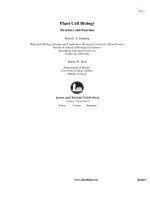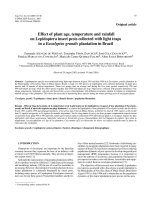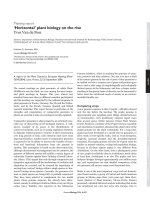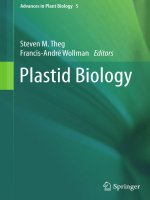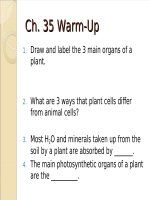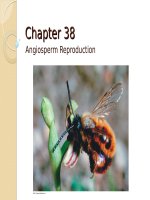Insect Plant Biology
Bạn đang xem bản rút gọn của tài liệu. Xem và tải ngay bản đầy đủ của tài liệu tại đây (12.45 MB, 440 trang )
Insect–Plant Biology
This page intentionally left blank
Insect–Plant Biology
Second Edition
Louis M. Schoonhoven
Joop J.A. van Loon
Marcel Dicke
Laboratory of Entomology, Wageningen University, The Netherlands
1
AC
Great Clarendon Street, Oxford OX2 6DP
Oxford University Press is a department of the University of Oxford.
It furthers the University’s objective of excellence in research, scholarship,
and education by publishing worldwide in
Oxford New York
Auckland Cape Town Dar es Salaam Hong Kong Karachi
Kuala Lumpur Madrid Melbourne Mexico City Nairobi
New Delhi Shanghai Taipei Toronto
With offices in
Argentina Austria Brazil Chile Czech Republic France Greece
Guatemala Hungary Italy Japan Poland Portugal Singapore
South Korea Switzerland Thailand Turkey Ukraine Vietnam
Oxford is a registered trade mark of Oxford University Press
in the UK and in certain other countries
Published in the United States
by Oxford University Press Inc., New York
# Oxford University Press 2005
The moral rights of the author have been asserted
Database right Oxford University Press (maker)
First edition first published 1998 by Chapman & Hall
Second edition first published 2005
All rights reserved. No part of this publication may be reproduced,
stored in a retrieval system, or transmitted, in any form or by any means,
without the prior permission in writing of Oxford University Press,
or as expressly permitted by law, or under terms agreed with the appropriate
reprographics rights organization. Enquiries concerning reproduction
outside the scope of the above should be sent to the Rights Department,
Oxford University Press, at the address above
You must not circulate this book in any other binding or cover
and you must impose the same condition on any acquirer
British Library Cataloguing in Publication Data
Data available
Library of Congress Cataloging in Publication Data
Schoonhoven, L.M.
Insect-plant biology / Louis M. Schoonhoven, Joop J.A. van Loon,
Marcel Dicke. — 2nd ed.
p. cm.
ISBN 0–19–852595–8 (alk. paper) — ISBN 0–19–852594–X (alk. paper)
1. Insects—Food. 2. Insect-plant relationships. I. Loon, J.J.A. van.
II. Dicke, Marcel. III. Title.
QL496.S38 2005
2005019634
595.717 0 85—dc22
Typeset by Newgen Imaging Systems (P) Ltd., Chennai, India
Printed in Great Britain
on acid-free paper by
Ashford Colour Press, Hampshire
ISBN 0–19–852594–X 978–0–19–852594–3
ISBN 0–19–852595–8 (Pbk.) 978–0–19–852595–0 (Pbk.)
1 3 5 7 9 10 8 6 4 2
This book is dedicated to Vincent G. Dethier, Tibor Jermy, John S. Kennedy,
and Jan de Wilde, whose pioneering contributions paved the way of
modern research in the biology of insect–plant interactions
This page intentionally left blank
Foreword to the second edition
It is widely known that plants and insects make up
approximately half of all known species of multicellular organisms. They have been evolving
together for over one hundred million years, with
varying levels of interaction leading to the selection
of characters that are studied today in every branch
of biology, from biochemistry and genetics to
behaviour and ecology.
The interactions between insects and plants may
be mutualistic, as with some specialized flowerpollinator pairs, and the overall importance of
insects as pollinators gave rise to the earliest detailed
studies of plant-insect relationships two hundred
years ago. Antagonistic interactions, in particular
between crops and herbivorous insects, have provided the inspiration for many studies in the past
hundred years, leading to greater understanding of
plant chemistry, insect physiology and behaviour
and ecology. The ability to establish molecular
phylogenies has led to renewed interest in the degree
of co-evolution of plants with insects. In these
studies, complexities revealed themselves in the
form of multiple interactions—with microorganisms, fungi, predators and parasitoids of insects—all
impacting how interactions between plants and
insects develop, vary, and evolve. By contrast, many
examples of herbivores being inconsequential in the
lives of plants have also been found.
Today, the field of plant-insect interactions
encompasses the whole gamut of relationships,
across the complete range of biological disciplines.
We think, not just of an insect herbivore choosing to
eat an undefended plant, but of the many historical
factors that influence the choice made, the phenotypic plasticity of behaviour, the different trophic
levels playing a part in the response, the sensory
and neural determinants of the choice, the consequences of it for the herbivore, the plant genes
activated in their turn and the potential selection
pressures elicited in either or both directions. We
know that ecological as well as physiological factors influence diet breadth. We know that an insect
population restricted to a plant species may
become genetically isolated in the first step of a
speciation event. We recognize that while insect
evolution follows plant evolution the reciprocity of
close co-evolution is not necessarily present.
This book amply demonstrates the breadth of the
field, with the three authors bringing their combined expertise and experience to all aspects of
Insect–Plant Biology. From the vast literature on
the topic the authors have selected examples of
experiment and theory to produce a book that is a
comprehensive guide for students and researchers
alike. From an overview of the patterns found in
nature, they move logically to plant structure and
chemistry, host finding and host choice, including
variation and insect physiology. The later chapters
include coverage of ecology and evolution, insect
and flower interactions, and last, to applications of
knowledge in insect-plant interactions.
Since 1998, when the first edition of this book was
published, advances have been made particularly in
plant biochemistry and evolution. Molecular techniques have elucidated details in these and other
areas, and the understanding of insect-plant biology
has broadened. With the inclusion of Marcel Dicke
among the authors, some of the newer work as well
as the topic of co-evolution get a somewhat different
treatment, and throughout the book, there are
additions and updates. For anyone with an interest
in any aspect of plant and insect interactions, this
text will be a firm and reliable resource.
Elizabeth A. Bernays
University of Arizona
Tucson
May 2005
vii
This page intentionally left blank
Preface to the second edition
Apart from offering an update motivated by the
rapidly expanding literature of the past seven
years, this second edition differs in two respects
from the previous one. First, Dr. Tibor Jermy, one of
the founders of the field of insect-plant relations
and co-author of the first edition, bears no
responsibility for the present book. Yet his extensive knowledge and views on the subject can be
traced back in the present edition. It is with pleasure that we dedicate this volume to Tibor Jermy, to
express our respect for his deep insights and longlasting contributions to the development of insectplant biology.
The second difference with the first edition
relates to recent changes in the scientific approach
of the multifaceted way in which insects and plants
interact with each other and with their environment. New insights into, among others, the
molecular biology of chemoreception and induced
plant defences and their effects on higher trophic
levels allow a more comprehensive approach of the
theme of this book than could be envisaged only a
few years ago. Studying insect-plant interactions at
the molecular level adds an exciting dimension to
our understanding.
We are indebted to several colleagues, who have
read and commented on chapters, including Tibor
Jermy, Peter de Jong, Erich Staădler, and Freddy
Tjallingii. We thank them for their encouragement
and help. Hans Smid produced some marvellous
new photographs and several other colleagues
have allowed us to reproduce some of their finest
micrographs. M.D. gratefully acknowledges the
NERC Centre for Population Biology of Imperial
College at Silwood Park (UK) and its director
Charles Godfray, as well as Maarten and Elly
Koornneef (Cologne, Germany) for providing a
hospitable and inspiring environment when
working on this second edition.
We are especially grateful to everyone at the
Production Department of Oxford University Press
for their stimulation and help with turning our text
into what we hope will be a useful and stimulating
book.
Wageningen, Summer 2005
L.M. S.
J.J.A. v. L.
M. D.
ix
Preface to the first edition
Green plants cover most of the terra firma on planet
Earth. Insects are dominant among plant consumers. The interactions between plants trying to
avoid consumption, and insects trying to optimize
food exploitation, are the subject of this book. It is a
rich subject: the primary literature has grown during the past 25 years at an exponential rate. It is also
an intellectually challenging subject since, in spite
of the wealth of facts, the principles underlying
insect–plant interactions are still largely unknown.
This book aims to categorize the multitude of facts
derived from studies in natural surroundings as
well as agricultural environments, and attempts to
indicate emerging lines of understanding. Hopefully it will serve as an introduction to students of
this area of biology and will highlight to general
biologists the complexity of interactions between
organisms.
The need for increased agricultural production,
together with the necessity to reduce the use of
insecticides, forces agricultural entomologists to
study how plants in nature have survived insect
attack over the aeons, and whether these defence
systems can be adopted in agricultural settings.
Therefore this book may also be helpful to applied
entomologists, who are in search of new ways to
protect our daily food production.
The information abounding in the recent literature is too extensive to attempt any complete
review. Therefore we have selected studies which
were especially appealing to us. In this process we
must have missed other equally (or more) important reports and opinions, for which we apologize.
In addition to trying to offer an objective representation of facts and thoughts as found in the
existing literature we have unavoidably, but also
deliberately, given some personal views as well.
x
We wish to dedicate this book to the memory of
three great men who have deeply influenced our
thoughts on this subject and who can be considered
as founding fathers of the field: Jan de Wilde,
Vincent G. Dethier, and John S. Kennedy. Without
their foresight, their stimulating enthusiasm, and
their perceptiveness of basic mechanisms operative
in nature the field of insect–plant relationships
would not have reached its present prominence.
Many people have provided generous assistance
in a variety of ways—stimulating discussions,
frank criticism, the provision of material for illustrations, and permission to use published diagrams
and information. We should especially like to
mention those who have read parts of the manuscript and made useful suggestions for improvement: T.A. van Beek, J. Beetsma, M. Dicke,
P. Harrewijn, M. van Helden, J.C. van Lenteren,
S.B.J. Menken, L. Messchendorp, C. Mollema,
´ . Szentesi, W.F. Tjallingii,
P. Roessingh, E. Staădler, A
and H.H.J. Velthuis. Last but not least our thanks
also go to the staff of Chapman & Hall for seeing
the book efficiently through production.
Wageningen, Budapest
Autumn 1996
L.M. S.
T. J.
J.J.A. v. L.
Contents
Foreword to the second edition by Professor Elizabeth Bernays
Preface to the second edition
Preface to the first edition
1 Introduction
1.1
1.2
1.3
1.4
1.5
Increased attention: why?
Relationships between insects and plants
Relevance for agriculture
Insect–plant research involves many biological subdisciplines
References
2 Herbivorous insects: something for everyone
2.1
2.2
2.3
Host-plant specialization
Food-plant range and host-plant range
Specialization on plant parts
2.3.1 Above-ground herbivory
2.3.2 Below-ground herbivory
2.4 Number of insect species per plant species
2.5 Herbivorous insects: are they plant taxonomists?
2.6 Host plant is more than food plant
2.7 Microclimates around plants
2.8 Extent of insect damage in natural and agricultural ecosystems
2.9 Compensation for herbivore damage
2.10 Conclusions
2.11 References
3 Plant structure: the solidity of anti-herbivore protection
3.1
3.2
3.3
3.4
3.5
Insect feeding systems
Leaf surface
3.2.1 Epicuticular waxes
3.2.2 Trichomes
Leaf toughness
3.3.1 Mandible wear
3.3.2 C3 and C4 plants
Structures involved in mutualistic relationships
Plant galls
vii
ix
x
1
1
1
2
2
3
5
6
10
11
11
13
13
15
16
17
18
23
24
24
29
29
31
31
35
36
36
39
40
41
xi
xii
CONTENTS
3.6
3.7
3.8
Plant architecture
Conclusions
References
4 Plant chemistry: endless variety
4.1
4.2
4.3
4.4
4.5
4.6
4.7
4.8
4.9
4.10
4.11
4.12
4.13
4.14
4.15
4.16
4.17
4.18
Plant biochemistry
4.1.1 Primary plant metabolism
4.1.2 Secondary plant substances
Alkaloids
Terpenoids and steroids
Phenolics
Glucosinolates
Cyanogenics
Leaf surface chemistry
Plant volatiles
Concentrations of secondary plant substances
Production costs
Compartmentation
Temporal variability
4.12.1 Seasonal effects
4.12.2 Day/night effects
4.12.3 Interyear variation
Effects of location and fertilizers
4.13.1 Sun and shade
4.13.2 Soil factors
Induced resistance
4.14.1 Induced direct resistance
4.14.2 Induced indirect resistance
4.14.3 Variation in herbivore-induced changes
4.14.4 Genomic and metabolomic changes induced by herbivory
4.14.5 Systemic effects
4.14.6 Long-term responses
4.14.7 Signal transduction
4.14.8 Interaction between herbivore-induced and
pathogen-induced changes
4.14.9 Plant–plant interactions
Genotypic variation
4.15.1 Inter-individual variation in plant chemistry
4.15.2 Intra-individual variation in plant chemistry
4.15.3 Plant sex affects insect susceptibility
Conclusions
Literature
References
5 Plants as insect food: not the ideal
5.1
5.2
Plants are suboptimal food
5.1.1 Nitrogen
5.1.2 Water
Artificial diets
42
43
44
48
49
50
50
51
52
55
57
57
58
59
63
65
67
68
69
70
71
71
71
73
74
75
75
77
77
78
79
80
80
81
81
81
83
84
85
85
86
99
101
102
104
105
CONTENTS
5.3 Consumption and utilization
5.3.1 Food quantities eaten
5.3.2 Utilization
5.3.3 Suboptimal food and compensatory feeding behaviour
5.3.4 Allelochemicals and food utilization
5.3.5 Detoxification of plant allelochemicals
5.4 Symbionts
5.4.1 Food utilization and supplementation
5.4.2 Detoxification of plant allelochemicals
5.5 Host-plant quality affected by microorganisms
5.5.1 Plant pathogens
5.5.2 Endophytic fungi
5.6 Host-plant effects on herbivore susceptibility to pathogens
and insecticides
5.7 Food-plant quality in relation to environmental factors
5.7.1 Drought
5.7.2 Air pollution
5.8 Conclusions
5.9 References
6 Host-plant selection: how to find a host plant
6.1
6.2
6.3
6.4
6.5
6.6
6.7
6.8
Terminology
Host-plant selection: a catenary process
Searching mechanisms
Orientation to host plants
6.4.1 Optical versus chemical cues
6.4.2 Visual responses to host-plant characteristics
6.4.3 Olfactory responses to host plants
6.4.4 Flying moths and walking beetles: two cases of olfactory
orientation
Chemosensory basis of host-plant odour detection
6.5.1 Morphology of olfactory sensilla
6.5.2 Olfactory transduction
6.5.3 Olfactory electrophysiology and sensitivity
6.5.4 Olfactory specificity and coding
Host-plant searching in nature
Conclusions
References
7 Host-plant selection: when to accept a plant
7.1 The contact phase of host-plant selection: elaborate
evaluation of plant traits
7.2 Physical plant features acting during contact
7.2.1 Trichomes
7.2.2 Surface texture
7.3 Plant chemistry: contact-chemosensory evaluation
7.4 The importance of plant chemistry for host-plant selection:
a historical intermezzo
xiii
106
106
106
111
113
116
120
120
121
121
122
122
124
125
125
125
127
127
135
136
137
138
143
143
145
149
149
152
152
153
154
157
158
160
160
169
169
170
170
172
172
173
xiv
CONTENTS
7.5
7.6
7.7
7.8
7.9
7.10
7.11
Stimulation of feeding and oviposition
7.5.1 Primary plant metabolites
7.5.2 Plant secondary metabolites promoting acceptance: token stimuli
7.5.3 Generally occurring secondary plant metabolites acting as stimulants
Inhibition of feeding and oviposition
7.6.1 Deterrency as a general principle in host-range determination
7.6.2 Host-marking as a mechanism to avoid herbivore competition
Plant acceptability: a balance between stimulation and deterrency
Contact-chemosensory basis of host-plant selection behaviour
7.8.1 Contact chemoreceptors
7.8.2 Gustatory coding
7.8.3 Caterpillars as models for coding principles
7.8.4 Token stimulus receptors: unsurpassed specialists
7.8.5 Sugar and amino acid receptors: detectors of nutrients
7.8.6 Deterrent receptors: generalist taste neurons
7.8.7 Peripheral interactions
7.8.8 Host-plant selection by piercing–sucking insects
7.8.9 Oviposition preference
7.8.10 Host-plant selection: a three-tier system
Evolution of the chemosensory system and host-plant preferences
Conclusions
References
8 Host-plant selection: variation is the rule
8.1
8.2
8.3
8.4
8.5
8.6
8.7
8.8
8.9
8.10
Geographical variation
Differences between populations in the same region
Differences between individuals
Environmental factors causing changes in host-plant preference
8.4.1 Seasonality
8.4.2 Temperature
8.4.3 Predation risks
Internal factors causing changes in host-plant preference
8.5.1 Developmental stage
8.5.2 Insect sex affects food choice
Experience-induced changes in host-plant preference
8.6.1 Non-associative changes
8.6.2 Associative changes
Pre- and early-adult experience
Adaptive significance of experience-induced changes in host preference
Conclusions
References
9 The endocrine system of herbivores listens to host-plant signals
9.1
Development
9.1.1 Morphism
9.1.2 Diapause
174
174
176
179
180
181
181
182
183
183
183
185
186
188
188
190
192
194
195
197
198
199
209
209
211
212
213
213
214
215
215
215
216
217
217
221
224
225
226
227
233
233
233
236
CONTENTS
9.2
xv
Reproduction
9.2.1 Maturation
9.2.2 Mating behaviour
Conclusions
References
237
237
239
241
241
10 Ecology: living apart together
244
9.3
9.4
10.1
10.2
10.3
10.4
10.5
10.6
10.7
10.8
10.9
10.10
10.11
10.12
10.13
Effects of plants on insects
10.1.1 Plant phenology
10.1.2 Plant chemistry
10.1.3 Plant morphology
10.1.4 Alternative food
Effects of herbivores on plants
Above-ground and below-ground insect–plant interactions
Microorganisms and insect–plant interactions
Vertebrates and insect–plant interactions
Indirect species interactions in communities
10.6.1 Exploitative competition
10.6.2 Apparent competition
10.6.3 Trophic cascades
Species interactions and phenotypic plasticity
Top-down versus bottom-up forces
Food webs and infochemical webs
10.9.1 Food webs
10.9.2 Infochemical webs
Communities
10.10.1 Why are so many herbivorous insect species ‘rare’?
10.10.2 Colonization
10.10.3 Community development
Molecular ecology
Conclusions
References
11 Evolution: insects and plants forever in combat
11.1
11.2
11.3
11.4
11.5
11.6
Fossilized records of insect–plant interactions
Speciation
11.2.1 Reproductive isolation
11.2.2 Rates of speciation
11.2.3 Reciprocal speciation
Genetic variation in host-plant preference of insects
11.3.1 Interspecific differences
11.3.2 Intraspecific differences
11.3.3 Preference–performance correlation
11.3.4 Genetic variation and local host-plant adaptation
Genetic variation in plant resistance against insects
Selection and adaptation
Evolution of insect diversity
245
246
247
249
249
251
252
252
254
254
256
257
257
259
260
261
261
263
264
265
265
266
267
269
270
278
279
282
283
286
286
287
287
287
289
289
290
291
292
xvi
CONTENTS
11.7 Evolution of host-plant specialization
11.7.1 Coping with plant secondary metabolites
11.7.2 Competition
11.7.3 Reduced mortality from natural enemies
11.7.4 Phylogenetic relationships
11.8 Reciprocal evolution of herbivorous insects and their host plants
11.8.1 Criticism of the theory of co-evolution
11.8.2 Support for the theory of co-evolution
11.9 Conclusions
11.10 References
12 Insects and flowers: mutualism par excellence
12.1 Mutualism
12.2 Flower constancy
12.2.1 Flower recognition
12.2.2 Flower handling
12.3 Pollination energetics
12.3.1 Distance
12.3.2 Accessibility
12.3.3 Temperature
12.3.4 Food-source evaluation
12.3.5 Reward strategy
12.3.6 Signalling nectar status
12.4 Pollinator movement within multiple-flower inflorescences
12.5 Competition
12.6 Evolution
12.7 Nature conservation
12.8 Economy
12.9 Conclusions
12.10 References
13 Insects and plants: how to apply our knowledge
13.1 Which herbivorous insect species become pests and why?
13.1.1 Characteristics of herbivorous pest species
13.1.2 Consequences of crop-plant introductions
13.1.3 Agricultural practices promote the occurrence of pest problems
13.2 Host-plant resistance
13.2.1 Host-plant resistance mechanisms
13.2.2 Partial resistance
13.2.3 Plant characteristics associated with resistance
13.2.4 Methodology of resistance breeding
13.3 Polycultures: why fewer pests?
13.3.1 The disruptive-crop hypothesis
13.3.2 The enemies hypothesis
13.3.3 Trap-cropping and crop–weed systems
13.3.4 Diversity as a guiding principle
293
293
294
294
294
296
297
298
300
300
306
308
311
312
314
316
316
317
317
318
319
320
321
322
324
329
330
330
331
336
337
337
337
338
339
339
340
341
342
345
348
348
349
350
CONTENTS
13.4 Plant-derived insecticides and antifeedants
13.4.1 Antifeedants
13.4.2 Neem tree, azadirachtin
13.4.3 Outlook for antifeedants as crop protectants
13.5 Weed control by herbivorous insects
13.5.1 Opuntia and Salvinia
13.5.2 Success rate of biological weed-control programmes
13.6 Conclusion: diversification holds the clue to the control of
pestiferous insects
13.7 References
xvii
350
351
352
353
355
355
356
357
358
Appendices
A: Further reading
Books that focus wholly or to a large extent on insect–plant interactions
Proceedings of international symposia on insect–plant relationships
364
364
365
B: Structural formulae of selected secondary plant compounds
367
C: Methodology
373
C.1 Choice of plants and insects
C.1.1 Plants
C.1.2 Insects
C.2 Behaviour
C.2.1 Olfactory orientation
C.2.2 Feeding
C.2.3 Oviposition
C.3 Sensory physiology
C.3.1 Ablation
C.3.2 Electrophysiology
C.4 Plant chemistry
C.4.1 Headspace
C.4.2 Leaf surface
C.4.3 Plant interior
C.4.4 Gene expression patterns
C.5 References
373
373
374
374
375
376
377
378
378
378
378
378
378
379
379
380
Taxonomic index
387
Author index
393
Subject index
412
This page intentionally left blank
CHAPTER 1
Introduction
1.1
1.2
1.3
1.4
1.5
Increased attention: why? . . . . . . . . . . . . . . . . . . . . . . . . . . . . . . . . . . . . . . . . . . . . . . . . . . . . . . . . . . . . . . . . . . . . . . . . . . .
Relationships between insects and plants . . . . . . . . . . . . . . . . . . . . . . . . . . . . . . . . . . . . . . . . . . . . . . . . . . . . . . . . . . . . .
Relevance for agriculture . . . . . . . . . . . . . . . . . . . . . . . . . . . . . . . . . . . . . . . . . . . . . . . . . . . . . . . . . . . . . . . . . . . . . . . . . . . .
Insect–plant research involves many biological subdisciplines . . . . . . . . . . . . . . . . . . . . . . . . . . . . . . . . . . . . . . . . . . .
References . . . . . . . . . . . . . . . . . . . . . . . . . . . . . . . . . . . . . . . . . . . . . . . . . . . . . . . . . . . . . . . . . . . . . . . . . . . . . . . . . . . . . . . . .
Almost a century and a half ago W. Kirby and
W. Spence described in their legendary book on
entomology3 the flight of a large white butterfly in
pursuit of a suitable plant to lay eggs on: ‘she is in
search of some plant of the cabbage tribe. Led by
an instinct far more unerring than the practised eye
of the botanist, she recognizes the desired plant
the moment she approaches it; and upon this she
places her precious burden.’ The authors then pose
one of the basic questions, which has occupied
scholars of insect–plant relationships till the present day: ‘But how is she to distinguish the cabbage
plant from the surrounding vegetables?’ The
answer given—‘She is taught of God!’3—shows
that the precise relationship between herbivorous
insects and their host plants has for a long time
defied causal analysis. Scientific inquiry into the
mechanisms of host-plant selection by herbivorous
insects started around 1900,2,9 but for a long time
roused curiosity among only a few biologists.
Roughly half a century ago zoologists began the
causal analysis of insect behaviour such as hostplant discrimination, and gradually some insight
has been gained into the underlying mechanisms.
1.1 Increased attention: why?
There are several reasons why insect–plant interactions are receiving increasing attention from
biologists as well as agronomists. It is now recognized that, from the perspective of fundamental
knowledge of the earth’s biosphere, the relationships between insects and plants are of crucial
importance. First there is the quantitative factor: the
1
1
2
2
3
Plant Kingdom and the class of insects represent
two very extensive taxa of living organisms, both in
abundance of species and in amount of biomass.
Green plants form by far the most voluminous
compartment of living matter (Fig. 1.1), whereas
insects are the leaders in number of species.
As ecologist Robert May6 puts it: ‘To a rough
approximation, and setting aside vertebrate chauvinism, it can be said that essentially all organisms
are insects.’ Certainly not only their variety but also
their total volume is colossal, in spite of their small
body sizes. For instance, the biomass of all insects
in temperate terrestrial ecosystems outweighs that
of the total land vertebrate population by about
10 to 1 (Fig. 1.2).7
1.2 Relationships between insects
and plants
The two empires, herbivorous insects and plants,
are united by intricate relationships. Animal life,
including that of insects, cannot exist in the absence
of green plants, which serve as the primary source
of energy-rich compounds for heterotrophic
organisms. On the other hand, long-standing
exposure to animals has supposedly been a major
cause in developing great diversity in the plant
world. Insects, with their overwhelming variation
in form and life history, may have been one of the
forces in shaping the plant world.5 Such a role has
been postulated by Ehrlich and Raven,1 who in a
seminal paper attributed the plant–herbivore
interface as the major zone of interaction for generating the present diversity of terrestrial life forms.
1
2
INSECT–PLANT BIOLOGY
Biomass (kg/ha)
100 000
Plants
10 000
Bacteria
Fungi
Earthworms Insects
1000
Algae
100
Livestock
Humans
Birds Mammals
10
Organism group
Figure 1.1 The average biomass of humans, their livestock, and the estimated biomass of natural biota of some other major groups
of organisms per hectare in the USA. Insects include also non-insect arthropods. Note logarithmic scale. (Data from Pimentel and Andow,
1984.)7
living world, thus rendering insect–plant interactions a unique and scientifically very fruitful area of
biological research.
1.3 Relevance for agriculture
Figure 1.2 In this drawing the ant represents the biomass of all ant
populations and the ant-eater the biomass of all land vertebrates
in the Brazilian Amazon. The ants alone outweigh the vertebrates
by about four to one. If all other social and non-social insects
were included, this ratio would be nine to one. (Drawings by
R.J. Kohout and E. Wright.)
The terrestrial flowering plants are the sine qua non
of the insect tribe, for it is among the insects that
feed upon these that herbivory reaches its highest
degree of specialization. Such species present a
series of complex relationships that are more easily
understood if we first consider separately several of
their peculiarities. Probably no other interactions
between two groups of organisms comparable
in type and extent can be found elsewhere in the
Obviously insect–plant interactions are also of
crucial importance from an applied point of view.
Insects remain, and may even have increased significance as, the chief pests of crops and stored
products, despite expensive and environmentally
hazardous control measures (Fig. 1.3).
There is an irrefutable need to understand better
the factors governing the relationships between
insects and plants, as this may help to unravel the
causes of insect pest development. Such knowledge
is fundamental when attempting to create biologically safe control strategies intended to prevent
insect pest outbreaks. The study of insect–plant
relationships therefore constitutes, as Lipke and
Fraenkel4 aptly put it, ‘the very heart of agricultural
entomology.’
1.4 Insect–plant research involves
many biological subdisciplines
Insect–plant interactions include problems at different levels of biological analysis. Questions such as
Insects
Plant
pathogens
Human food
Weeds
Average no. of publications/year
INTRODUCTION
3
7000
6000
5000
4000
3000
2000
1000
0
1
9
0
2
8
3
6
4
5
7
–7 6–7 9–8 2–8 5–8 8–9 1–9 4–9 7–9 0–0
3
7
8 98 98 99 99 99 00
7 97 9
9
9
1
1
1
2
1
1
1
1
1
1
Period
Figure 1.3 Estimated potential crop losses during preharvest to
insects (13%), diseases (12%), and weeds (12%) in the USA.
(Data from Pimentel, 1997.)8
‘Why do cabbage worms devour cabbage leaves,
but refuse to eat potato plants?’ lie at the level of the
organism, whereas the question ‘Why are some
forests more prone to insect outbreaks than others?’
requires an ecological approach. The focus in this
book is upon the mechanistic analysis at the level of
the organism, including a physiological and molecular biological approach. Ecological aspects,
however, have not been neglected, because insights
derived from studies at the organismal level are
often useful elements in ecological models. Another
reason for including a discussion of ecological
aspects is that the function of many behavioural or
physiological traits becomes obvious only when
put in an ecological perspective.
As in other biological subdisciplines, students of
insect–plant interactions may be interested in
proximate puzzles (how?) or in ultimate factors
(why?). Questions like ‘How does an insect recognize its host plant?’ and ‘How does a herbivore
avoid being poisoned by toxic compounds in its
food plant?’ belong to the first category. Questions
like ‘Why do desert plants contain more terpenoids
than species occurring in pastures?’ and ‘To which
extent have insects stimulated the evolution of
flowering plants?’ relate to ultimate causes. Physiologists and molecular biologists are concerned
mainly with proximate factors, whereas students of
evolution concentrate on finding ultimate causes.
Figure 1.4 Primary references (from 1973 to July 2002) drawn from
the Commonwealth Agricultural Bureau (CAB) database. The bars
represent the average numbers per year of all publications fitting the
search statement (insect or mite) AND (plant or host plant) AND
(journal article). All descriptor fields used.
Both approaches in fact complement each other and
will therefore be employed in this book, but in
many instances without explicitly referring to
either type.
The topic of insect–plant interactions is too
extensive to be covered comprehensively in a book
of this size. The rapidly growing interest in this
field is evidenced by the real flood of scientific
papers (Fig. 1.4), including many extensive reviews
and several books (Appendix A), published during
the past two or three decades. The amount of
information becoming available cannot be collected, let alone absorbed by a single individual.
The following text therefore attempts to derive
general principles, illustrated with a limited number of specific examples. As the species-to-species
variation in behavioural responses and physiological adaptations is huge, the reader interested in
a specific insect–plant relationship is referred to
reviews or the primary literature.
1.5 References
1. Ehrlich, P.R. and Raven, P.H. (1964). Butterflies and
plants: a study in coevolution. Evolution, 18, 586–608.
2. Errera, L. (1886). Un ordre de recherche trop ne´glige´.
L’efficacite´ des structures de´fensives des plantes.
4
3.
4.
5.
6.
INSECT–PLANT BIOLOGY
Comptes Rendus des Se´ances de la Socie´te´ Royale de
Botanique Belgique, 25, 80–99.
Kirby, W. and Spence, W. (1863). An introduction to
entomology (7th edn). Longman, Green, Longman,
Roberts & Green, London.
Lipke, H. and Fraenkel, G.S. (1956). Insect nutrition.
Annual Review of Entomology, 1, 17–44.
Marquis, R.J. (2004). Herbivores rule. Science, 305,
619–21.
May, R.M. (1988). How many species are there on
earth? Science, 241, 1441–9.
7. Pimentel, D. and Andow, D.A. (1984). Pest management and pesticide impacts. Insect Science and its
Application, 5, 141–9.
8. Pimentel, D. (ed.) (1997). Techniques for reducing
pesticides: environmental and economic benefits. Wiley,
Chichester.
9. Verschaffelt, E. (1910). The cause determining the
selection of food in some herbivorous insects.
Proceedings Royal Academy, Amsterdam, 13, 536–42.
(Reprinted in Proceedings Koninklijke Nederlandse
Akademie van Wetenschappen, 100, 362–68, 1997.)
CHAPTER 2
Herbivorous insects: something
for everyone
2.1
2.2
2.3
Host-plant specialization . . . . . . . . . . . . . . . . . . . . . . . . . . . . . . . . . . . . . . . . . . . . . . . . . . . . . . . . . . . . . . . . . . . . . . . . . .
Food-plant range and host-plant range . . . . . . . . . . . . . . . . . . . . . . . . . . . . . . . . . . . . . . . . . . . . . . . . . . . . . . . . . . . .
Specialization on plant parts . . . . . . . . . . . . . . . . . . . . . . . . . . . . . . . . . . . . . . . . . . . . . . . . . . . . . . . . . . . . . . . . . . . . . .
2.3.1 Above-ground herbivory . . . . . . . . . . . . . . . . . . . . . . . . . . . . . . . . . . . . . . . . . . . . . . . . . . . . . . . . . . . . . . . . . . . .
2.3.2 Below-ground herbivory . . . . . . . . . . . . . . . . . . . . . . . . . . . . . . . . . . . . . . . . . . . . . . . . . . . . . . . . . . . . . . . . . . . .
2.4 Number of insect species per plant species . . . . . . . . . . . . . . . . . . . . . . . . . . . . . . . . . . . . . . . . . . . . . . . . . . . . . . . . . .
2.5 Herbivorous insects: are they plant taxonomists? . . . . . . . . . . . . . . . . . . . . . . . . . . . . . . . . . . . . . . . . . . . . . . . . . . . .
2.6 Host plant is more than food plant . . . . . . . . . . . . . . . . . . . . . . . . . . . . . . . . . . . . . . . . . . . . . . . . . . . . . . . . . . . . . . . .
2.7 Microclimates around plants . . . . . . . . . . . . . . . . . . . . . . . . . . . . . . . . . . . . . . . . . . . . . . . . . . . . . . . . . . . . . . . . . . . . . . .
2.8 Extent of insect damage in natural and agricultural ecosystems . . . . . . . . . . . . . . . . . . . . . . . . . . . . . . . . . . . . . .
2.9 Compensation for herbivore damage . . . . . . . . . . . . . . . . . . . . . . . . . . . . . . . . . . . . . . . . . . . . . . . . . . . . . . . . . . . . . . .
2.10 Conclusions . . . . . . . . . . . . . . . . . . . . . . . . . . . . . . . . . . . . . . . . . . . . . . . . . . . . . . . . . . . . . . . . . . . . . . . . . . . . . . . . . . . . . .
2.11 References . . . . . . . . . . . . . . . . . . . . . . . . . . . . . . . . . . . . . . . . . . . . . . . . . . . . . . . . . . . . . . . . . . . . . . . . . . . . . . . . . . . . . . .
Insects have the most species of any class of
organisms on earth and green plants make up the
greatest part in all biomass on land. Nearly half of
all existing insect species feed on living plants.
Thus, more than 400 000 herbivorous (synonymous
with phytophagous) insect species live on roughly
300 000 vascular plant species (Fig. 2.1).
According to some recent estimates, the total
number of insect species is considerably larger than
was previously thought and may range from 4 to
10 million.82,85 If this reflects reality, the number of
vegetarian species probably needs to be adjusted
Green plants
22%
6
10
11
11
13
13
15
16
17
18
23
24
24
proportionally. The relativity of estimations of
species numbers is, however, strikingly demonstrated by publications that diagnose species
homogeneity by DNA sequencing. The application
of such protocol to, for instance, the neotropical
butterfly Astraptes fulgerator revealed that this species forms a mimetic assemblage of at least 10 different species, with their adults showing little
phenotypic diversity, but their larvae characterized
by mostly different food plants.53
Herbivory does not occur to the same extent in
all insect groups. The members of some orders of
Herbivorous
insects
26%
Vertebrates 4%
Protozoa 2%
Other invertebrates
15%
Non-herbivorous
insects
31%
Figure 2.1 The proportions of plant and animal
species in major taxa, excluding fungi, algae, and
microbes. (From Strong et al., 1984.)113
5
6
INSECT–PLANT BIOLOGY
insects are almost exclusively herbivorous, whereas
in other orders herbivory occurs less frequently or
is even absent. Conspicuous among the herbivores
are the Lepidoptera (butterflies and moths),
Hemiptera (bugs, leaf-hoppers, aphids, etc.),
Orthoptera (grasshoppers and locusts), and some
small orders such as the Thysanoptera (thrips) and
Phasmida (walking sticks). A large part of the vast
horde of herbivorous insects belongs to the speciose
orders Coleoptera, Hymenoptera, and Diptera, all
three of which also include numerous species with
predatory and parasitic habits (Table 2.1).
Given the innumerable plant-infesting insect
species it is not surprising that all terrestrial tracheophytes (vascular plants) harbour some members of the herbivore tribe. Although at some time it
was assumed that evolutionarily ancient plants,
such as the maidenhair tree (Ginkgo biloba), a ‘living
fossil’ (Fig. 2.2), and ferns were devoid of insect
consumers, it is now known that this tree,125 as well
as other relicts of a glorious past, including
ferns,54,93,94
lycopods,61,104
mosses,66,108,110
66,78
22
lichens,
and mushrooms, serve as food to at
least some insect species.
Table 2.1 Numbers of herbivorous species in different insect
orders (data from various sources)
2.1 Host-plant specialization
Insect order
Coleoptera
Lepidoptera
Diptera
Hymenoptera
Hemiptera
Orthoptera
Thysanoptera
Phasmida
Total no. of
species
Herbivorous species
No.
%
349 000
119 000
119 000
95 000
59 000
20 000
5 000
2 000
122 000
119 000
35 700
10 500
53 000
19 900
4 500
2 000
35
100
30
11
90
100
90
100
Figure 2.2 Ginkgo biloba. Shoot with young leaves and male
inflorescence.
One of the most striking features of insect–plant
relationships is the high degree of food specialization among herbivorous insects. This phenomenon
forms the heart of these relationships, and all discussions in the following chapters are pervaded
with this notion. It is therefore useful to consider
the degree of dietary specialization or generalization shown by herbivores. Insects that in nature
occur on only one or a few closely related plant
species are called monophagous. Many lepidopterous larvae, hemipterans, and coleopterans fit into
this category. Oligophagous insects, such as the
cabbage white butterfly (Pieris brassicae) and the
Colorado potato beetle (Leptinotarsa decemlineata),
feed on a number of plant species, all belonging to
the same plant family, the Brassicaceae and the
Solanaceae, respectively. Polyphagous insect species
seem to exercise little choice and accept many
plants belonging to different plant families. The
green peach aphid (Myzus persicae), for instance,
has been recorded to feed during summertime on
members of more than 50 plant families. Its winter
host plant, however, is the peach tree (Prunus
persica) or closely related rosaceous plants.
This classification into three categories, however,
is fairly arbitrary, because precise definitions of
monophagy and oligophagy are difficult to sustain.
The first problem is that there is a completely
graded spectrum between species that will eat
only a single kind of plant and those that regularly
consume many very diverse plants. Second, individuals of the same insect species may show different host-plant preferences in different areas of its

